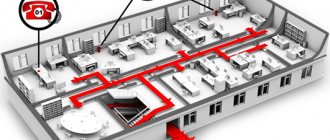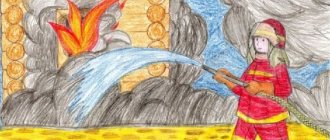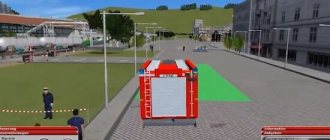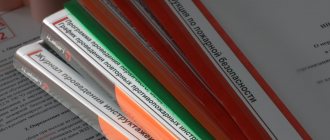Card index of games according to fire safety rules
Card index of games according to fire safety rules
Didactic game: “Loto - fire safety”
Goal: using story pictures to form children’s understanding of dangerous situations during a fire; the ability to behave correctly in a dangerous situation. Develop attention, logical thinking, coherent speech. Foster a sense of responsibility.
Progress of the game:
The teacher gives the players cards drawn into 10 empty rectangles (playing fields), then shows the children a plot picture depicting the situation during a fire (a boy plays with matches, a girl ran out onto the balcony of a burning apartment, an iron was left unattended, children turned on the Christmas tree, etc. ). The child, who has correctly described the situation, covers the empty playing field with a picture. The one who has the most closed fields wins.
Didactic game "Card Quiz".
Goal: to consolidate children's knowledge about fire safety rules. Develop memory, thinking, speech. Foster a sense of responsibility.
Progress of the game:
The teacher lays out on the table, or puts in a beautifully decorated box, cards with questions on the topic of rules of behavior during a fire. The child who answers the question correctly gets a chip. The one who has the most chips at the end of the game wins.
Question options:
— Name the possible cause of the fire;
- how to call the fire department correctly;
- what to do if during a fire there is no way to call the fire brigade, and the routes out of the house are cut off by the fire;
— is it possible to extinguish a fire without first calling the fire brigade;
- what to do if there is a smell of gas in the house;
— is it possible to hide in a closet or under a table during a fire;
— Is it possible to set poplar fluff on fire?
— is it possible to create a draft during a fire by opening all windows and doors at the same time;
— is it possible to use the elevator during a fire in the house;
— what needs to be saved first during a fire: money, documents or yourself;
— how to properly leave a smoky room;
— Is it possible to play with matches and lighters and why.
Didactic game: “Name the causes of the fire”
Goal: to develop knowledge about the causes of fire. To develop attention, memory, speech. Cultivate responsibility.
Progress of the game:
From the plot pictures proposed by the teacher (children collecting autumn leaves, children hanging burning candles on the Christmas tree, a boy playing with matches in the closet, children watering flowers, etc.), the child must choose those situations that could cause a fire and justify his answer, for that gets the chip. The one who has the most chips at the end of the game wins.
Didactic game: “Choose the right one”
Goal: to develop children’s knowledge about the items needed when extinguishing a fire, the rules for their use. Reinforce knowledge about objects that can cause a fire. Develop speech, memory, logical thinking. Foster a sense of responsibility.
Progress of the game:
The child is offered a set of subject pictures (fire extinguisher, bucket of water. TV. Telephone, sandbox, electrical outlet, fire hose, kerosene lamp, fireman's helmet, lighter, gas stove, gas mask) from which he must select those used in extinguishing fires and those that are the cause. occurrence of a fire. The one who answers correctly gets a chip. The player who receives the most chips wins.
Didactic game: “Fold the picture”
Goal: to consolidate knowledge about the rules of behavior during a fire. Develop imagination, logical thinking, fine motor skills. Cultivate perseverance.
Progress of the game:
The child must put together a picture cut into 8-10 parts depicting a fire situation.
Card index of games according to fire safety rules
Didactic game: “Loto - fire safety”
Goal: using story pictures to form children’s understanding of dangerous situations during a fire; the ability to behave correctly in a dangerous situation. Develop attention, logical thinking, coherent speech. Foster a sense of responsibility.
Progress of the game:
The teacher gives the players cards drawn into 10 empty rectangles (playing fields), then shows the children a plot picture depicting the situation during a fire (a boy plays with matches, a girl ran out onto the balcony of a burning apartment, an iron was left unattended, children turned on the Christmas tree, etc. ). The child, who has correctly described the situation, covers the empty playing field with a picture. The one who has the most closed fields wins.
Summary of a physical education lesson on fire safety in the preparatory group of a kindergarten
Summary of a physical education lesson for children 6-7 years old on the topic “Fire Safety.”
“We follow the rules and don’t get into trouble” Abstract: This summary of a physical education lesson is addressed to physical education instructors and teachers of educational institutions working with children 6-7 years old. The event does not require special training for children and the teacher and can be implemented in educational activities within the framework of the “Fire Safety” week, and is aimed at preserving and strengthening the health of students, expanding and clarifying knowledge about the profession of firefighter and fire safety. Goal: implementation of fire prevention propaganda among pupils, parents and staff of a preschool educational institution. Tasks: - practice walking with stepping over an obstacle, running while completing buildings on a signal; — improve motor skills in basic types of movement (crawling, climbing, jumping), develop balance in walking on a limited surface; — teach children safe behavior and actions in fire conditions; — create conditions for improving the general culture of students in fire safety behavior and fire prevention; — cultivate respect for the firefighting profession. Equipment and materials: gymnastic wall, gymnastic mats, cord, racks for climbing and stepping over, hoops 10 pcs., skittles 12 pcs., cones 4 pcs., ball 1 pc., A2 sheets 2 pcs., felt-tip pens according to the number of children, cards thematic, audio recording. Preliminary work: reading works and conversations on the topic “Fire Safety”, looking at propaganda posters, watching videos and cartoons, excursion to the city fireplace.
I. Introductory part.
Children go into the hall and line up in a column.
Greetings. The teacher
reads out a riddle about the profession of firefighter.
Our calling is to fight fire, to protect people from harm - that’s the task! We come to the rescue everywhere and always, Our main assistant is, of course, water! In a helmet, like a glorious warrior, He hurries to the fire... (firefighter) Children's answers. The teacher
asks the children a question: what qualities should a firefighter have?
Summarizes the children's answers and suggests doing a warm-up in order to develop these qualities. Rebuilding the column one by one. walking, walking with high knees, hands to shoulders, stepping over gymnastic poles. Walking in a squat, hands on knees, between cones (4 pcs.), placed at a distance of 1 m. Crawling with support on elbows and knees, under arcs (height 50 cm, 4 pcs.), placed at a distance of 1 m. Jumping on two legs moving forward. Running while completing the task on the whistle - stop, clap your palms above your head. Alignment. Didactic game “What does a firefighter need for work?” The teacher shows the children pictures depicting various objects and asks them to answer the question, which of them do firefighters need for work?
If an item is needed for a firefighter’s work, children take a step forward; if not needed, they perform a squat. List of pictures: helmet, fire extinguisher, flashlight, axe, mask (respirator), walkie-talkie, bucket, fire hose, fire truck and any subject pictures not related to the topic of the lesson (6-8 pieces). The teacher marks the children who have reached the conditional finish line. II. Main part.
Formation in 1 column, formation in 4 columns in fours.
ORU "Fire Truck". 1. "Flashing beacon." I.P. standing, feet hip-width apart, arms along the body. 1 - Raise your arms up to your sides and clap your palms. 2 - Return to I.P. 6-8 times. 2. "Steering wheel". I.P. standing, feet shoulder-width apart, arms along the body. 1 – Raise your arms straight forward to chest level. 2 – Rotate the body to the right. 3- Turn the body to the left. 4 - Return to I.P. 6-8 times. 3. “Pump up the tires.” I.P. standing, feet slightly wider than shoulder-width apart, hands at chest level, fingers clasped. 1 - Perform a deep bend. 2 – Return to I.P. 6-8 times. 4. "Fire escape". I.P. – main stand. 1- Sit down, clasp your knees with your hands. 2 - Straighten up - bend over - raise your straight arms up. 3 – Lower your hands. 4 – Return to I.P., 6-8 times. 5. “Fire hose.” I.P. lying down, legs together, arms straight behind the head. 1 – turn to the right, lie on your stomach. 2- return to I.P. 3-4 – Same to the left. 6 – 8 times. 6. “Checking readiness.” Jumping on two legs with a turn from side to side. 8 jumps alternating with walking in place 2 - 3 times. Alignment. Visual gymnastics “Where is the fire?” The teacher
tells the children that before the advent of telephones, firefighters learned about fires by observing the area from a fire tower.
Invites children to train their eyesight. Children put out their right hand straight with their thumb raised up, and, as directed by the teacher, move their hand to the right - left, up or down. They follow the movement of the thumb only with their eyes, without moving their head. The teacher draws the children’s attention to their posture and makes sure that the children do not raise their shoulders. Calculation for the first - second. ATS “Fire crew training” Subgroup method of execution. 1. Crawling on bellies on mats under a cord stretched at a height of 40 cm from the floor. Distance 4 m. 3 times. Walk along the cord with your right - left side with an extended step and straight, placing your heel to your toe. Distance 4 m. Control of posture by children is mandatory. 2. Climbing onto a gymnastic ladder in different ways and moving to the next flight. 3 times. Pay attention to the correct placement of the foot on the rail and the correct grip. Jumping over the cord from the right to the left on two legs moving forward. Distance 4 m. Formation in a circle. The teacher
notes the children’s success in performing basic physical activities.
Tells children that the profession of fire rescuer is important and significant. However, it is important to follow fire safety rules to prevent a fire. Didactic game “True - False” The teacher reads out a statement, if the children agree with the statement, they clap, if they disagree, they stomp. — Children can use electrical appliances without adults. — Children should not use a gas stove without an adult. — Children can light fires themselves. — Matches for children are not a toy. — Electrical appliances should not be touched with wet hands. — Children can set off firecrackers without adult supervision. — In case of a fire, you should call 01 or 112. — In case of a fire, you need to leave the apartment and seek help from your neighbors. The teacher
summarizes and reads out the correct statements, and marks the children who completed the task.
Outdoor game - relay race "Obstacle Course". Children are formed into three teams.
At the teacher’s signal, the first participant overcomes the obstacle course (climbing into a tunnel, jumping on two legs from hoop to hoop, stepping over obstacles of different heights). Takes 1 card from the hoop. Running “snake” between the pins (6 pieces at a distance of 1 m) he returns to the team and passes the baton by touch. When all the cards have been transferred, children choose cards with fire safety situations that are correct in their opinion and paste them onto an A2 sheet using markers and felt-tip pens and complement the poster with drawings. Teams show posters to each other, explain their choice and check whether the opposing team completed the task correctly. The teacher sums it up and suggests placing posters in the group room (Safety Center) and in the kindergarten lobby. III. Final part.
Formation in a circle.
The teacher
invites the children, tossing the ball from hand to hand, to answer the questions: what new did you learn today? Who do they want to tell about the lesson? Which exercises were difficult to do and which ones were easy? Why is it important to follow fire safety rules? The teacher summarizes the lesson. The teacher says goodbye to the children. The children leave the hall.
We recommend watching:
Physical education leisure in a preparatory school group. Scenario Physical education lesson for children 6 - 7 years old. Synopsis of a physical education lesson with children of the preparatory group Synopsis of a story-based physical education lesson in the preparatory group of a kindergarten with presentation
Similar articles:
Lesson in the preparatory group “Fire – friend or foe?”






